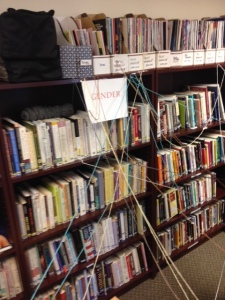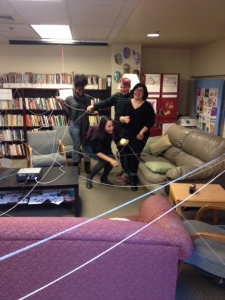Social Justice Can Be Messy!
A reflection from Women’s Center Director, Jess Myers
Last week, the Women’s Center staff completed spring training. As with all of our training days, we took the opportunity to explore our social identities in the spirit of self-exploration, team building, and a commitment to critical social justice. It’s something I look forward to each training knowing I always learn more about my fellow team members and myself.
This semester we did the Power of Assumptions activity which I’ve facilitated several times before at UMBC. It can be a great low-risk activity to get students considering their personal identities and those of others for the first time. It prompts students to consider how their identities have impacted their life experiences while also calling them to face assumptions and stereotypes they might have of others. With a student staff well versed in social justice 101, though, I wanted to take this activity to a new level, and conveniently the finding of bags full of yarn as we’ve been cleaning out the Women’s Center put me in the creative mood to do just that. Now, students would be asked to take a ball of yarn with them and leave a marker on each identity they visited throughout the exercise. As we were promoted with statements such as “This identity brings me the most joy,” This part of my identity is the most invisible,” “This part of my identity I have to defend the most,” and so forth, we moved around the Women’s Center leaving behind a paths of yarn that quickly took the shape of interesting tangled webs.
As I moved about the room, I quickly realized what a challenge it was to get to my next location as I walked over or under the yarn of my staff members. Suddenly, the yarn wasn’t just yarn but also the lived experiences and lives of the five others sharing the space with me. I wanted to be gentle in my steps. I wanted to take extra care in moving the yarn up or down as I weaved in and out across the room. Half way through the activity, I almost contemplated staying at the identity I already was because the thought of crossing back across the room through the web of those meaningful identities and stories and my staff members seemed really complicated and messy.
And, then I paused as my mind flashed back to the first time I did this activity as a participant when I was in grad school. I was just beginning the journey of coming out and navigating what being a queer women felt like and meant for me. I was doing this in space that didn’t always feel safe for me and during a time when my cohort didn’t always trust each other. I remember the panic of having to pick which identities I would move to after each prompt. What did that mean for me? What would my classmates think? I rarely moved from sexual orientation throughout that activity. It was such a salient identity for me at the time. It took all of my brain power and heart beats and waking hours for me to understand what being queer meant. I didn’t have the space or capacity to consider my other identities and how they intersected with this new understanding of what sexual orientation meant and would be for me. How different and freeing it was to be able to move around the room again some six years later!
With this in mind, I began thinking in new ways about the activity we were doing and what it now meant for me. My yarn trail began to form into new analogies for me. It continued to stay a web that represented my intersecting identities but it also took the shape a trail a plane leaves in the sky as it flies to its destination. Sometimes as the sun is setting, I think how pretty the wispy streaks of white clouds look in the pink sky until I remember they’re just left over fumes of pollution (womp womp). Carbon foot prints. What did all this yarn I was tracing throughout the room, in and out, and over and under, others trails of yarn mean in terms of the space I take up and the impact I leave with others in the wake of all my intersecting identities? While it was freeing to move around the room, what does this movement call me to consider in regards to my privilege? In what ways can I be gentler with myself and others to reduce the negative impact of oppression?
As we debriefed the activity as a staff, one of the first comments to what the experience felt like was “messy.” As we continued to debrief, though, it became apparent that the others didn’t have the same first-time experience I had. They shared feeling safe in being vulnerable with each other even during some of the more challenging parts of the activity for them. The idea of feeling safe even while taking the risk to be vulnerable calls to the importance of creating brave spaces which is a practice we first learned about in the reflection discussion at last year’s Critical Social Justice (CSJ). It comes from a chapter written by Brian Arao and Kristi Clemens called From Safe Spaces to Brave Spaces: A New Way to Frame Dialogue Around Diversity and Social Justice and it resonated with us so much, it became the inspiration for this year’s CSJ. So all year long our staff has been exploring what creating brave spaces means for us in theory and practice. How can we foster learning environments that support the challenging work of authentic engagement when we’re talking about issues related to identity, oppression, power, and privilege? How do we meet individuals where they are at, take care to be gentle, and still push to go deeper? How can taking a risk feel both safe and brave at the same time? Aroa and Clemens lay out a great set of guidelines in their chapter that have helped us explore these questions and more. We also put together our own set of brave space guidelines we’re introducing to our Women’s Center community and groups this spring. We plan on also using them as a road map for our events, roundtables, and discussions in hopes to call attention to all of our intersecting webs and “carbon footprints” whether we can visibly see them or not.
So yes, social justice can be messy. But that’s okay! The mess is part of the growing, exploring, and striving to cultivate change. Where do you need brave spaces in your life? How will you create brave spaces for yourself and others?
Learn more by participating in the full week of CSJ events from February 16-20th.
Posted: January 27, 2015, 1:21 PM


